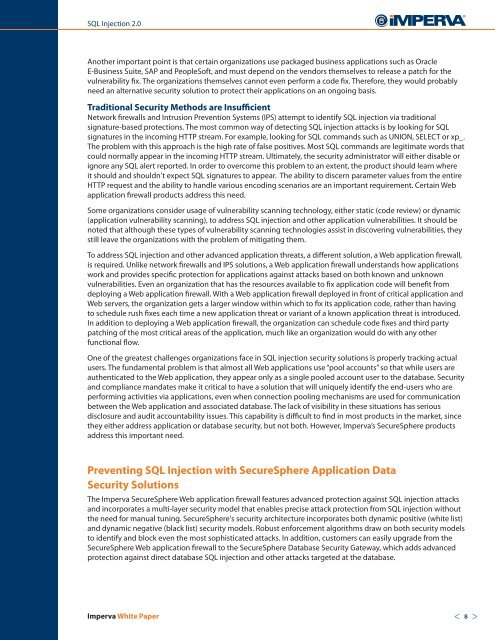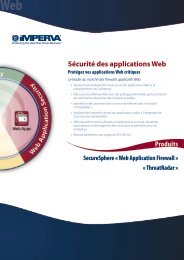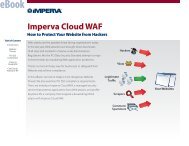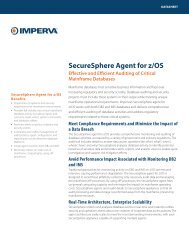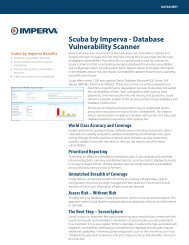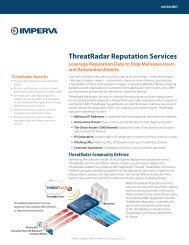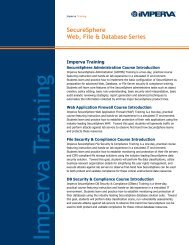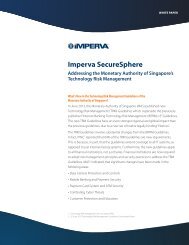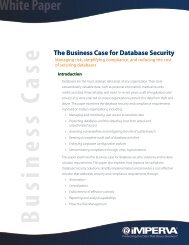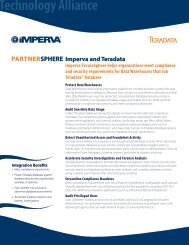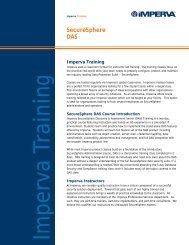SQL Injection 2.0 - Imperva
SQL Injection 2.0 - Imperva
SQL Injection 2.0 - Imperva
Create successful ePaper yourself
Turn your PDF publications into a flip-book with our unique Google optimized e-Paper software.
<strong>SQL</strong> <strong>Injection</strong> <strong>2.0</strong>Another important point is that certain organizations use packaged business applications such as OracleE-Business Suite, SAP and PeopleSoft, and must depend on the vendors themselves to release a patch for thevulnerability fix. The organizations themselves cannot even perform a code fix. Therefore, they would probablyneed an alternative security solution to protect their applications on an ongoing basis.Traditional Security Methods are InsufficientNetwork firewalls and Intrusion Prevention Systems (IPS) attempt to identify <strong>SQL</strong> injection via traditionalsignature-based protections. The most common way of detecting <strong>SQL</strong> injection attacks is by looking for <strong>SQL</strong>signatures in the incoming HTTP stream. For example, looking for <strong>SQL</strong> commands such as UNION, SELECT or xp_.The problem with this approach is the high rate of false positives. Most <strong>SQL</strong> commands are legitimate words thatcould normally appear in the incoming HTTP stream. Ultimately, the security administrator will either disable orignore any <strong>SQL</strong> alert reported. In order to overcome this problem to an extent, the product should learn whereit should and shouldn't expect <strong>SQL</strong> signatures to appear. The ability to discern parameter values from the entireHTTP request and the ability to handle various encoding scenarios are an important requirement. Certain Webapplication firewall products address this need.Some organizations consider usage of vulnerability scanning technology, either static (code review) or dynamic(application vulnerability scanning), to address <strong>SQL</strong> injection and other application vulnerabilities. It should benoted that although these types of vulnerability scanning technologies assist in discovering vulnerabilities, theystill leave the organizations with the problem of mitigating them.To address <strong>SQL</strong> injection and other advanced application threats, a different solution, a Web application firewall,is required. Unlike network firewalls and IPS solutions, a Web application firewall understands how applicationswork and provides specific protection for applications against attacks based on both known and unknownvulnerabilities. Even an organization that has the resources available to fix application code will benefit fromdeploying a Web application firewall. With a Web application firewall deployed in front of critical application andWeb servers, the organization gets a larger window within which to fix its application code, rather than havingto schedule rush fixes each time a new application threat or variant of a known application threat is introduced.In addition to deploying a Web application firewall, the organization can schedule code fixes and third partypatching of the most critical areas of the application, much like an organization would do with any otherfunctional flow.One of the greatest challenges organizations face in <strong>SQL</strong> injection security solutions is properly tracking actualusers. The fundamental problem is that almost all Web applications use “pool accounts” so that while users areauthenticated to the Web application, they appear only as a single pooled account user to the database. Securityand compliance mandates make it critical to have a solution that will uniquely identify the end-users who areperforming activities via applications, even when connection pooling mechanisms are used for communicationbetween the Web application and associated database. The lack of visibility in these situations has seriousdisclosure and audit accountability issues. This capability is difficult to find in most products in the market, sincethey either address application or database security, but not both. However, <strong>Imperva</strong>’s SecureSphere productsaddress this important need.Preventing <strong>SQL</strong> <strong>Injection</strong> with SecureSphere Application DataSecurity SolutionsThe <strong>Imperva</strong> SecureSphere Web application firewall features advanced protection against <strong>SQL</strong> injection attacksand incorporates a multi-layer security model that enables precise attack protection from <strong>SQL</strong> injection withoutthe need for manual tuning. SecureSphere's security architecture incorporates both dynamic positive (white list)and dynamic negative (black list) security models. Robust enforcement algorithms draw on both security modelsto identify and block even the most sophisticated attacks. In addition, customers can easily upgrade from theSecureSphere Web application firewall to the SecureSphere Database Security Gateway, which adds advancedprotection against direct database <strong>SQL</strong> injection and other attacks targeted at the database.<strong>Imperva</strong> White Paper< 8 >


